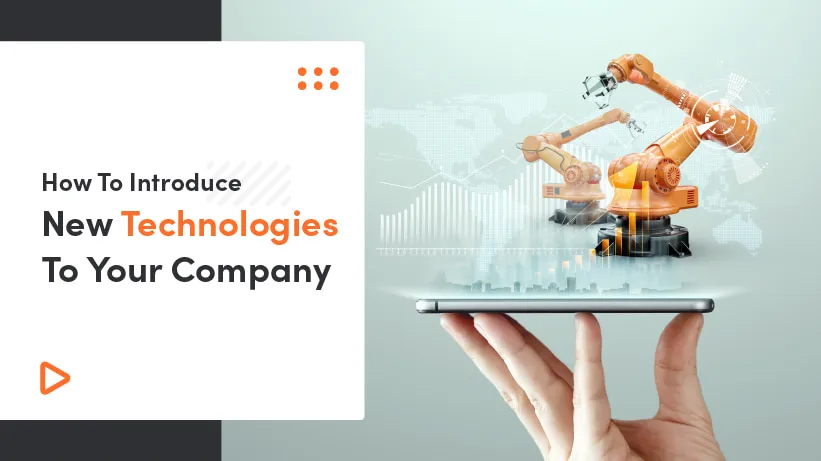Change is inevitable. With the constant development of programming, new technologies emerge and companies that want to stay on top need to keep up with them. Many of them decide to switch the main technology behind their products or update the tech stack they offer with the freshest software development languages. As a result, the question of how to bring technological innovations to the organization and motivate developers to use them arises. This post will attempt to answer the enigma by providing a few pointers on how to do it effectively and with the fewest problems possible.
According to Gallup, more than 70% of change projects fail, but this doesn't have to be the case if you adopt an efficient strategy. Today, we will talk about some of the most significant obstacles that organizations encounter when introducing new technologies and how to overcome them.
Why do Workplace Technology Initiatives Fail?
Many organizations struggle to implement new workplace technology after months of study, justification, and planning or realize that employees aren't utilizing it. Here are some of the most common explanations:

Technology is too Complex
Since there are so many levels associated with building large enterprise resource planning (ERP) systems, they are extremely prone to error. Since the system touches many different functions and departments, any misconfiguration can have serious and costly effects. In certain cases, business losses like delayed vendor invoices or payroll difficulties have led to organizations litigating the vendor or implementation partner.
New Technology doesn't Integrate with Existing Software
Everyone is frustrated by the technology that does not integrate smoothly with existing software and apps. It results in workarounds, which slow down everyone and eventually discourage people from utilizing it.
Employees don't Understand its Value
If your employees don't comprehend the challenge that new workplace technology is supposed to tackle, it won't have much of an influence.

What are the Benefits of Introducing New Technologies to a Company?
According to collaborative research, employees are more engaged, productive, and happy at work when their basic technology configuration works effectively and their collaborative effort brings results. According to the report, 59% believe that having access to current technology allows them to effectively serve their clients and operate more efficiently.
Utilizing the newest technology in the workplace to help your business become mobile and more contemporary has nearly limitless benefits.
Employee Happiness and Productivity are Up
If you provide your workers with the resources and software and let them use them in a way that better fits them, they will become more productive and effective and hence happier. Employees who do more work of higher quality make more revenue and boost profitability. Satisfied employees are more likely to stay with your company for longer than switch to rivals, saving you money on turnover.
The Ability to Provide Greater Customer Service
Companies have effectively sold to their clients and provided faster and more personalized customer service thanks to technological switches. From using analysis to find where to place relevant advertisements to investing in the community listening to identify your customers' pain areas to providing rapid support via digital chatbots or automatic emails, technology can help you enhance your customer experience. This can help your business stand out from the competition, resulting in higher income and long-term loyalty.
The Ability to Recruit Talent from Beyond the Area
Introducing new tech can also help you bring fresh talent from a bigger pool of applicants. Expanding your technical offering gets you new sales and recruitment opportunities. Organizations can now hire the best staff and industry specialists regardless of where they live.

Top Challenges of Introducing New Technologies to Employees
While new technologies and methods can bring significant benefits, you may not notice the advantages if they aren't properly applied. The introduction of new technology, especially ‘on the edge technologies’, should start with a presentation of advantages standing behind a particular solution. People in the company should see a Proof of Concept or be presented with an alternative version of an existing application - where the main module is written in the new technology - and a chance to test it. It is worth discussing the success stories of big companies using the said solution. Be prepared to present the technology’s life cycle - some technologies can be deprecated and no longer maintained, which may entail additional risk.
We should be aware that there are also risks such as additional costs, time restrictions or lack of needed experience. At the very beginning, feature delivery efficiency will be lowered. If the technology is still quite new the availability of experts will be limited. What is more, you risk the personal brand of your company, which introduces the risk of a great failure.
Before you start
According to David Johnson, a principal analyst at Forrester Research Inc. who guides organizations on employee experience and workplace efficiency, organizations often rush into implementing a shiny new technology that doesn't integrate well with their existing workflow. This occurs, he claims, when managers fail to grasp how people perform their duties on a granular level and how new technologies might help them execute their jobs more efficiently. As a result, unhappy employees may refuse to utilize the product or perform less successfully due to it. One approach to guarantee that technology is a good match is to test it with a small group of individuals.
Key steps for the successful introduction of new technologies
You can't resist implementing new methods of doing things using additional tools, even if it's difficult.
So, let's look at the top practices for successful implementation requires new technology for your business.
Prepare a plan

The more fully you respond to the problem, the better for the organization. Make a detailed strategy of your goals and requirements and how the new technology will meet them.
Your new software will need to be implemented in phases, which may include the following:
- Assessment of all functional tasks relevant to software capabilities
- Educating company key stakeholders on technology capabilities and business expectations
- Assembly of an implementation team
- Appointment of an internal champion
- Appointment of an internal point person for tech questions
- Data migration
- Employee training
- Pilot program
- “Go-live”
- Review of first week/month
- Fine-tuning of the software and employee use
- Ongoing technical support
- Performance evaluation at 6-month and 1-year intervals
Your plan's transfer of duty and accountability is extremely crucial. Who will be in charge of marketing the expenditure to internal stakeholders, such as other software power users? Who will be in charge of the implementation, and who will compile a list of questions and concerns to discuss with the vendor?
Know your reasons for choosing the technology
This begins with a personal grasp of the advantages. Scheduling a one-on-one demonstration where you can ask questions and see the technology action is a wonderful approach to ensure you understand precisely what it can accomplish. This is the most straightforward method of determining your investment's return.
After that, you should be able to explain why the program is the obvious victor so that you can enjoy the advantages with your team, particularly the product's major users. You should be willing to show product assistance and technical expertise. If not you, you should appoint a supporter, such as a project manager, to understand the ins and outs of the system and help your team adopt the new technology.
Don’t get discouraged by resistance
A new system will always take time and patience, regardless of the one you have in place currently. Even though your present tech is sluggish and inefficient, it is predictable and hence the route of low resistance in the short term. Let your staff know that there will be a period of adjustment and that they should expect one as well, but that once they grasp the new technology, the grass will be much greener on the other side.
Ensure your team understands the benefits
Make your team leaders and spokesperson continue to laud the technology's merits to each individual on a personalized level to ensure total buy-in. Connect the tech’s special advantages to the people who use it. Engage with the group and share the gains you've noticed in the business. To show the advantages, use key performance indicators.

Get employees involved
Businesses often make the error of bringing in technologies and procedures without consulting the individuals using them. Always get advice from your teammates on the finest technologies to utilize. You can appoint one or two people to check out various languages and provide recommendations.
Encourage sharing
Nobody likes to endure a tedious training course. If done correctly, your users will be unaware that they are learning (or being asked to change). Consider launching a celebration by hosting a lunch and learning or incorporating humor into your presentation. Make the decisions that are best for your employees and workplace culture.
Provide Support
"How can I _?" you might wonder. It's all part of the learning process. While your new construction application will include instructions and useful how-to resources, your staff may occasionally need to speak with a professional. Ascertain that they are aware of where to direct their inquiries. Tell them if you want them to speak to you or if you want them to go directly to technical assistance. Provide them with documentation, useful websites, and any other online or offline resources they might need.
Ask for employee feedback
Consider your team's leaders to be stakeholders. Maintain their involvement in the process and insist on receiving their feedback to fix any concerns as soon as possible. Employee buy-in will be boosted significantly if your champion, instructor, leading voice, and other team leaders remain committed. It's also an excellent chance for your team's leadership development.
Evaluate your staff regularly to keep track of the technological solution's success. Find out what aspects of the new technology interest each individual the most at first. Find out which job activities have been improved and where the time and cost reductions appear to be coming from (by position and function). Discover which areas of your workers' jobs they now like more and how the app has helped them perform better. Find out about their worries and problems. Meet and discuss and allow your team to analyze these new developments and queries to feel included in the decision-making process.
Mature technologies
On the other hand, the introduction of mature technology, with a well-established market position is a bit easier due to, for example, a vast number of meetups and hackathons. There is also the possibility of pair programming or taking part in workshops with more experienced developers, so a lot of learning opportunities for the developers. With mature frameworks also comes a big community offering constant support.
The big advantage here can be also the presence of leaders that make the process of implementing a lot easier, providing that we have a person that is willing to take over and build himself a team. A senior developer with a team of a couple of people will minimize risk.
The size of your company is also important here. The smaller it is, the easier it should be to change technologies, however, small companies are exposed to a bigger risk. This can be, for example, time waste - when we finally come to the conclusion that the chosen technology does not suit our needs. Also, more stable technologies entail a bigger chance your developers getting bored with them after some time. There is also a risk of losing a customer due to the failure of the implementation process or lack of a positive response from your team causing the entire venture to die. We should also be aware that the chosen technology may not solve all of our problems or be too strong for the solution we have in mind (so-called “overkill”).
Conclusion
Introducing new technology into the workplace can be a good thing. The adoption of new technology and software enhances production and the direction of the business.
To make change simpler, ensure you've addressed all of the variables outlined above before implementing new software or infrastructure.
- Train people
- Give them a heads up
- Personalize your training and support different learning styles
- Ask your employees to suggest new technology
Implementing change will be simpler if you follow these guidelines, but it will not be without struggle. Understanding this can assist you in making required organizational adjustments and supporting development. Before you start, consider aspects like framework maturity, company size, overall developers’ engagement and interest in the said technology.




